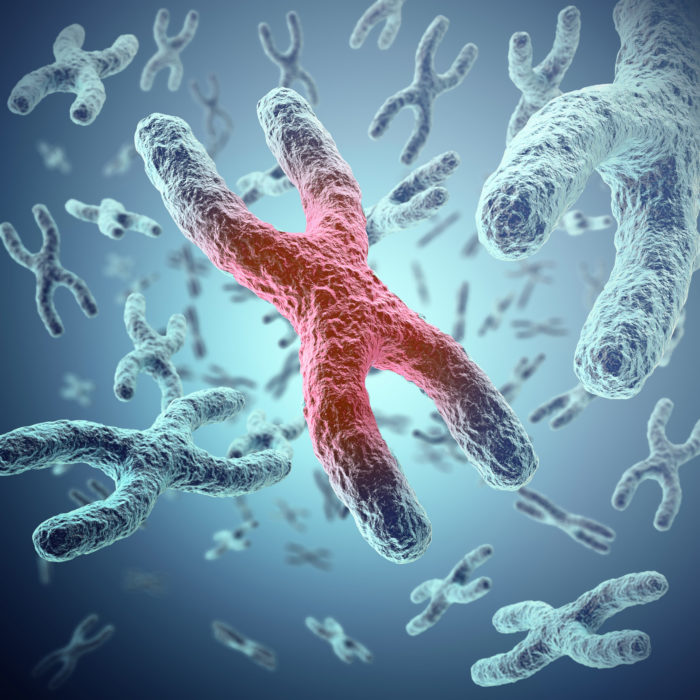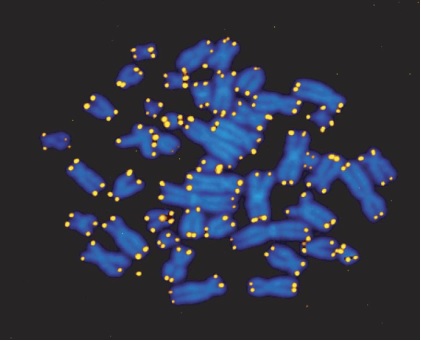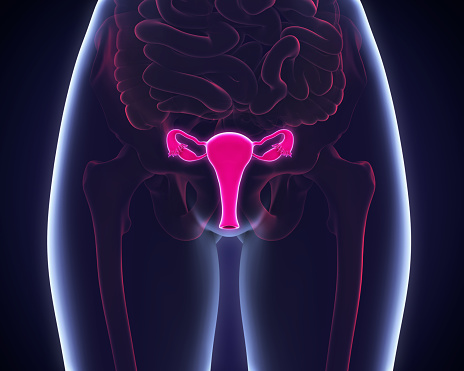
Cutting-Edge Natural Product TA-65 Turns On Longevity Gene
November 29th, 2016Cutting-Edge Natural Product TA-65 Turns On Longevity Gene
By Leslie J. Farer
In the past, halting the aging process was the goal of longevity enthusiasts. Now, research shows that it is possible to not just stop, but to reverse some of the infirmities associated with growing older and rejuvenate age-damaged tissues. Ensuring the integrity of telomeres, small segments of repeating DNA at the ends of our chromosomes which decay with time, may hold the key maintaining youthful vitality and vibrant health well into the 21st century. A novel concentrated plant extract known as TA-65 acts at the genetic level to maintain the structure of DNA, restore cellular function, and possibly keep you years younger than your chronological age.
What are Telomeres?
Telomeres are composed of a few hundred or more repeats of the nucleotide sequence TTAGGG (1,2) (where T= thymine; A = adenine; G= guanine) at the ends of chromosomes. They act as protective ‘caps’ preventing loss of DNA, and also guard against fusing, fraying and unraveling of chromosomes, (1,3,4) which could potentially expose and damage the genetic material.
Since investigators in the 1930’s coined the term telomere (from the Greek telos for ‘end’ and meros for ‘part’), a massive amount of research has been undertaken to explore the structure and function of these important chromosomal caps. In fact, the 2009 Nobel Prize in physiology and medicine was awarded to three scientists for their work involving telomeres.
Hayflick’s Fifty Year-Old Observation
Back in the 1960’s, geneticist Leonard Hayflick observed dividing human cells and made an important discovery that had a substantial impact on the future of anti-aging research. But before we examine his finding, let’s look very briefly at cell division, or mitosis ─ a fundamental, genetically-controlled process that enables a cell to duplicate itself, including chromosomes (through the process of DNA replication), to form two identical ‘daughter’ cells. Cell division allows an organism to develop and differentiate into an adult from multiple progressive stages beginning with the initial union of reproductive cells (the germ cells, egg and sperm), and after growth, to construct and repair tissues.
Hayflick reported that cultured human cells divide only a finite number of times in a progressive course leading to replicative senescence, (5) when they stop dividing altogether (the term senescence is roughly equivalent to ‘aging.’). Once cells have reached their proliferation maximum, or so-called Hayflick limit, they are likely to stop functioning properly and/or die through the process of apoptosis. (1,6,7)
Why do cells stop dividing when they reach their Hayflick limits? Is there a cellular mechanism that monitors and counts each cell division up until the final one? And does Hayflick’s observation have any relevance to aging?
In the early 1970’s, Russian scientist Alexey Olovnikov began to answer some of these questions ─ he made the connection between a DNA replication problem involving telomeres and the limitation on cell division reported by Hayflick.
Telomere Length Predicts the Replicative Potential of Cells
Olovnikov proposed that telomeres in somatic (body) cells shorten over time, whereas they maintain their length in reproductive cells, (8) and that the shortening is due to incomplete DNA transcription at the telomeric ends of chromosomes. (9) (Interestingly, James Watson, one of the discoverers of the structure of DNA, also recognized this problem of incomplete end-replication. (1,10)) As later confirmed, during mitosis in somatic cells, enzymes known as DNA polymerases can’t completely copy the end portions of chromosomal DNA (3,4,11), much the way a tape recorder can’t record sound at the very ends of the tape. Instead, a few dozen nucleotides are lost with each repeated cell division, (1,7) until telomeres reach a critical length, triggering the Hayflick limit and senescence. On the other hand, reproductive cells can divide indefinitely. Perhaps, Olovnikov must have thought, there is some biochemical factor operating in reproductive cells to maintain telomere length that is turned off in somatic cells.
In 1986, telomere length was directly linked to the replicative potential of cells when researchers observed, similarly to Olovnikov, that the length of telomeric nucleotide repeats capping sex chromosomes in sperm cells were longer than in somatic cells. They went on to conclude that the factor Olovnikov theorized must be responsible for maintaining telomere length (and unlimited cell division) in germ cells is the enzyme telomerase. (1,12) (Note: The same process of progressive telomere shortening that is characteristic of somatic cells, also occurs in stem cells,(1,13,14) which have the potential to develop and differentiate into various cell types needed by the body to repair damaged tissues. Obviously, arrested growth of stem cells poses a major problem for an organism’s repair and maintenance mechanisms.)
The hTERT Gene Turns On the ‘Immortalizing Enzyme,’ but Rarely, Leading to Aging and Age-Related diseases
Telomerase (telomere terminal transferase) is an enzyme that enables DNA polymerases to copy the entire strand of DNA, including the nucleotide repeats at the ends, during cell division, so that telomeres maintain their length and integrity. The switch that turns on telomerase expression is the human telomerase reverse transcriptase (hTERT) gene. Experiments have demonstrated that artificially expressing this gene in cells stimulates telomerase production and elongates telomeres, endowing cells with the ability to divide indefinitely. (1,4;15-17) Because of this capacity to induce unlimited cell replication, telomerase can be considered an ‘immortalizing’ enzyme.
The hTERT gene is activated in germ cells, in fetal tissues before birth, and in cancer cells, but turned off in most somatic cells (1,4,7,11) for most of life (except in certain immune cells and cells replenishing the gut lining), resulting in diminished production of telomerase, shortened telomeres, arrested cell division and its consequences: aging and age-related diseases.
Because of this association between shortened telomeres, replicative senescence, and senescence in general, telomere length is considered a biomarker of aging, (3) with the telomere acting as a cellular mechanism that determines longevity (or mortality), based on its progressively diminishing length with each cell division.
With advancing years, as an increasing number of our trillions of cells exhibit dysfunctional, eroding, uncapped telemeres, the body’s systems of defense, repair and maintenance become compromised. This leads to a cascade of degenerative pathologies: DNA damage, loss of tissue structure and function, impaired mitochondrial function, increased oxidative stress, and the development of diseases including cardiovascular disease, Parkinson’s, Alzheimer’s, cancer, and atherosclerosis, not to mention overall mortality. (1-4;6,11,13,18,19)
If the hTERT gene is the switch that turns on telomerase, enabling unlimited cell division potential and cellular immortality, then why is it turned off in most cells for most of life? Because, besides germ cells and fetal tissues, telomerase is also upregulated in tumors. (1,7,11) The good news is that nature has endowed our cells with a built-in safety mechanism: shortened telomeres and the Hayflick limit, reducing the chances of unlimited cell proliferation characteristic of cancerous cells. The bad news is that within our cells is a genetically programmed, ticking clock of aging.
Restoring Telomere Length Reverses Aging: the ‘Ponce de Leon Effect’
In a fascinating 2010 study published in the journal Nature, researchers not only halted, but reversed degenerating tissues and organs in a whole animal model (not just cells) of accelerated aging by restoring telomere length and activating telomerase. (19) The researchers, led by Ronald DePinho of Harvard Medical School, bred mice genetically programmed to be deficient in telomerase, producing, by the fourth generation, animals with markedly short, dysfunctional telomeres that presented with DNA damage, tissue degeneration in the spleen and intestines, testicular atrophy, decreased brain mass, and loss of the sense of smell. The investigators then brought these animals back from the brink of decay by reactivating telomerase. Treatment of test mice with a telomerase activator for just four weeks extended telomeres and initiated cell proliferation (most likely of stem cells, (4) leading to tissue regeneration), reduced DNA damage, and eliminated tissue deterioration in all of the organs examined. Amazingly, researchers observed a reversal of the neurodegeneration previously reported ─ activation of telomerase triggered neurogenesis, or the production of new brain cells, along with remyelination of neurons and an increase in brain mass. In addition, the animals’ sense of smell was restored, as was testicular mass and even fertility!
In essence, investigators genetically inactivated telomerase, producing telomere-compromised, age-accelerated, decrepit animals, then reactivated telomerase, reversing every pathology examined and restoring and rejuvenating cells, tissues, organs, and entire animals. The treated mice now appeared youthful and healthy! The authors referred to this transformation as an “unprecedented reversal of age-related decline” and DePinho later called it, less formally in an interview, “a Ponce de Leon effect.”
The Nature study concluded, “Accumulating evidence implicating telomere damage as a driver of age-associated organ decline and disease risk and the marked reversal of systemic degenerative [pathologies] in adult mice observed here support the development of regenerative strategies designed to restore telomere integrity.” (19)
‘Regenerative Strategy’ TA-65
So, can we rewind the cellular clock of aging and restore more youthful functioning by reactivating the ‘immortalizing’ enzyme?
Studies demonstrate that a natural telomerase activator, TA-65, derived from the astragalus plant, turns on the hTERT gene to lengthen telomeres in animal and human cells. (11,20) TA-65 is a purified extract of the root of Astragalus membranaceus, traditionally used in Chinese medicine. Developed by the California biotech company Geron Corporation, TA-65 was licensed to T.A. Sciences in New York in 2002 and is now available from International Antiaging Systems and sold as a dietary supplement, not a drug. Harvested from select farms in a small area of China, the active ingredient is extracted, concentrated and purified at an FDA-certified laboratory to produce a product at least 90% pure in TA-65. The product underwent many years of investigation and development at Geron prior to further research once licensed to T.A. Sciences.
A 2011 study by scientists from the Spanish National Cancer Centre in Madrid demonstrated that TA-65 increased average telomere length and decreased the percentage of extremely short telomeres in cells known as mouse embryonic fibroblasts (used in the culturing of mouse embryonic stem cells) and that the mechanism of action was through telomerase activation. In addition, an in vivo experiment in mice showed that TA-65, when supplemented in the diet, increased tissue telomerase levels, elongated ‘critically short’ telomeres, and improved age-related indicators including glucose tolerance, bone health and skin quality. (20)
A human study published in 2010 in the journal Rejuvenation Research evaluated the effects of TA-65 on telomerase activation and telomere length, specifically focusing on the immune system. The researchers studied data on 114 subjects between the ages of 51 and 75 (72% male) who, for one year, undertook an age-management program called the ‘Patton Protocol-1’ which consisted of TA-65 (10-50 mg daily), a multi-ingredient/vitamin supplement pack, quarterly lab testing and physician counseling. Results indicated that after one year, subjects exhibited a ‘positive remodeling’ of the immune system to a more youthful status, with declines in senescent cytotoxic T cells and natural killer (NK) cells. (11)
Cytotoxic T cells are a type of lymphocyte, or white blood cell that targets viruses, other pathogens, and tumors. During an infection, T cells must undergo extensive cell division to mount an effective response against the foreign invader. ‘Senescent’ cytotoxic T cells, as the name implies, can no longer divide and indicate a depleted immune system. But after TA-65 treatment for just three months, researchers saw a statistically significant ‘age-reversal’ in the number of these senescent T cells, particularly in those whose immune systems were compromised. NK cells are another type of cytotoxic lymphocyte that target tumors and viruses. The number of circulating NK cells tends to increase with age to compensate for reduced activity per cell, but after TA-65 administration for six months, researchers observed a more youthful profile in study subjects, with a decrease in NK cells.
Although average telomere length in the cells of study subjects did not increase after one year of supplementation, the percentage of cells with short telomeres decreased, leading researchers to conclude that telomerase “preferentially lengthens the shortest telomeres.” No adverse effects were reported when 50 mg per day or less was taken. (11)
In a small unpublished placebo-controlled anti-aging trial performed by T.A. Sciences, 24 men between the ages of 60 and 85 who received a TA-65 precursor (20 – 40 mg/daily) for 12 weeks showed improvements in immune function, eye sight, sexual function and skin quality, with no significant adverse effects.
TA-65 Safety
We saw earlier that the hTERT gene is turned on in germ cells and fetal tissues, as well as in cancer cells, so there is the question of whether activating telomerase may cause unwanted malignant cell proliferation. According to T.A. Sciences, since TA-65 supports and improves immune function, it should therefore suppress any tumor cell overpopulation. Additionally, in the 2011 animal study previously described, no significant cancer incidence was observed, and in the 2010 human study, no new cases of cancer were reported after treatment with TA-65.
TA65: ‘Changing the Nature of What Healthy Aging Means’
According to Noel Patton, founder of TA Sciences, “Scientists now understand the pervasive role telomeres play in the aging process. The effects of age-related decline are severe and the benefits of telomere rejuvenation can be profound. TA-65 has the potential to effectively lessen and possibly eliminate the crippling effects of aging decline caused by insufficient telomerase and short telomeres. Rejuvenating shortened telomeres will change the nature of what healthy aging means.”

Telomere repeats in a normal human lymphocyte, visualized by fluorescence, shown in yellow; DNA of chromosomes shown in blue.
Ref.: Aubert G, Lansdorp PM. Telomeres and aging. Physiol Rev. 2008 Apr;88(2):557-79.
References
- Aubert G, Lansdorp PM. Telomeres and aging. Physiol Rev. 2008 Apr;88(2):557-79.
- Martínez P, Blasco MA. Telomeric and extra-telomeric roles for telomerase and the telomere-binding proteins. Nat Rev Cancer. 2011 Mar;11(3):161-76.
- Paul L. Diet, nutrition and telomere length. J Nutr Biochem. 2011 Mar 21. [Epub ahead of print]
- Cox LS, Mason PA. Prospects for rejuvenation of aged tissue by telomerase reactivation. Rejuvenation Res. 2010 Dec;13(6):749-54.
- Hayflick L. The limited in vitro lifetime of human diploid cell strains. Exp Cell Res. 1965;37:614–636.
- Sahin E, Colla S, Liesa M, et al. Telomere dysfunction induces metabolic and mitochondrial compromise. Nature. 2011 Feb 17;470(7334):359-65. Epub 2011 Feb 9.
- Zvereva MI, Shcherbakova DM, Dontsova OA. Telomerase: structure, functions, and activity regulation. Biochemistry (Mosc). 2010 Dec;75(13):1563-83.
- Olovnikov AM. Principle of marginotomy in template synthesis of polynucleotides. Dokl Akad Nauk SSSR. 1971;201(6):1496-9.
- Olovnikov AM. A theory of marginotomy. The incomplete copying of template margin in enzymic synthesis of polynucleotides and biological significance of the phenomenon. J Theor Biol. 1973; 41: 181– Watson JD. Origin of concatemeric T7 DNA. Nat New Biol. 1972;239: 197–201.
- Harley CB, Liu W, Blasco M, et al. A natural product telomerase activator as part of a health maintenance program. Rejuvenation Res. 2011 Feb;14(1):45-56. Epub 2010 Sep 7.
- Cooke HJ, Smith BA. Variability at the telomeres of the human X/Y pseudoautosomal region. Cold Spring Harb Symp Quant Biol.1986 51: 213–219.
- Sahin E, Depinho RA. Linking functional decline of telomeres, mitochondria and stem cells during ageing. Nature. 2010 Mar 25;464(7288):520-8.
- Marión RM, Blasco MA. Telomeres and telomerase in adult stem cells and pluripotent embryonic stem cells. Adv Exp Med Biol. 2010;695:118-31.
- Bodnar AG, Ouellette M, Frolkis M., et al. Extension of life-span by introduction of telomerase into normal human cells. Science. 1998;279: 349–352.
- Vaziri H, Benchimol S. Reconstitution of telomerase activity in normal human cells leads to elongation of telomeres and extended replicative life span. 1998;Curr Biol 8: 279–282.
- Condon J, Yin S, Mayhew B, et al. Telomerase immortalization of human myometrial cells. Biol Reprod. 2002 Aug;67(2):506-14.
- Eisenberg DT. An evolutionary review of human telomere biology: the thrifty telomere hypothesis and notes on potential adaptive paternal effects. Am J Hum Biol. 2011 Mar-Apr;23(2):149-67. Epub 2010 Dec 17.
- Jaskelioff M, Muller FL, Paik JH, et al. Telomerase reactivation reverses tissue degeneration in aged telomerase-deficient mice. Nature. 2011 Jan 6;469(7328):102-6. Epub 2010 Nov 28.
- de Jesus BB, Schneeberger K, Vera E, Tejera A, Harley CB, Blasco MA. The telomerase activator TA-65 elongates short telomeres and increases health span of adult/old mice without increasing cancer incidence. Aging Cell. 2011 Mar 22[Epub ahead of print].








